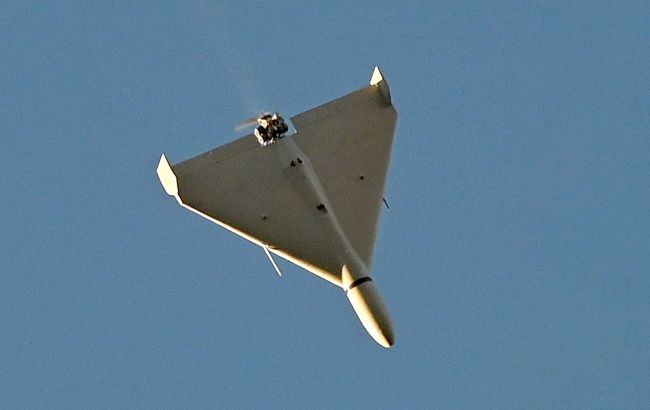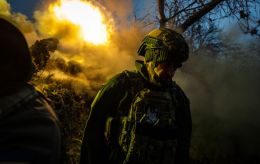Cluster munitions and nails: How dangerous could Russia’s drones become?
 Photo: Russian drones dropped cluster munitions during the May 1 attack on Kyiv (Getty Images)
Photo: Russian drones dropped cluster munitions during the May 1 attack on Kyiv (Getty Images)
Russian forces are using drones armed with payloads, from cluster munitions to ordinary nails, during air attacks on Ukrainian civilians. The enemy resorts to these methods to inflict greater harm on civilians.
RBC-Ukraine's article describes the latest incidents and how Russia is turning drones into an instrument of terror.
Takeaways:
-
What exactly exploded yesterday in the Kyiv suburbs after the Shahed strikes?
-
Why does the danger persist even after the drone attack has ended?
-
Why can the fragments left behind after the UAV attack be hazardous?
-
What is the purpose of filling Russian drones with nails?
Explosions after attack: Cluster munitions dropped by drones may have detonated in Kyiv
On May 1 in Kyiv, following a nighttime drone strike, about ten explosions were reported the next morning in the Bortnychi district. The Ministry of Internal Affairs (MIA) stated that bomb‑disposal teams are working in the Darnytskyi district.
"Access to areas that may be hazardous to citizens is restricted by police. Please understand these temporary measures and follow the recommendations of rescuers and law enforcement officers. The main rule: do not touch unknown objects. If you find any, call 101 or 102," the MIA press service said.
The MIA did not specify what caused the explosions. Meanwhile, the Kyiv City Military Administration reported that unidentified explosive devices detonated.
In total, ten blasts occurred in the forest‑park area of Darnytskyi district. One explosion struck the roof of a residential building, partially damaging it and injuring an elderly woman.
"The explosive component of the downed drone detonated with a delay. An elderly resident of Darnytskyi district was wounded," Mayor Vitali Klitschko wrote.
The Darnytskyi District State Administration, however, suggested these may have been delayed‑action cluster munitions scattered overnight by Russian drones over Bortnychi.
"If you find a suspicious object, immediately move to shelter and call the police, giving them the exact location," the administration’s statement read.
Kyiv City Military Administration head Tymur Tkachenko also speculated that the explosions were caused by cluster munitions dropped from UAVs:
"But we can say for certain only after a specialized examination to determine the origin of these explosive elements," he noted.
Local authorities are not sure what exactly exploded in Bortnychi yesterday. However, they note that, according to the available information as of now, cluster munitions that were scattered by Russian UAVs exploded.
"We’ll know the exact types and origin of these munitions only after a special examination," Kyiv City Military Administration spokesperson Yevhen Ievlev said.
He added that this was "the second series of scattering of such explosives, and I can say with absolute certainty that those that detonated yesterday carried much larger charges than the ones that were scattered by Russian drones for the first time."

Photo: This could be the kind of munitions that Russian drones scattered during the attack on Kyiv, according to Kyiv City Military Administration (t.me/tkachenkotymur)
"They’re already small, but what remains are extremely tiny fragments, which makes it very difficult to conduct an examination in a short time," explains Ievlev.
He also warned that even if these particles had been lying after the attack for more than a day, they still remain dangerous.
"You can’t say that because it’s been lying there for a day, it’s safe to approach. Under no circumstances should you go near it. It can react to anything: light, vibration, heat, movement, pressure," he emphasized, urging people to call the relevant services immediately.
At the same time, aviation expert Valerii Romanenko is skeptical that cluster munitions could detonate from light or pressure.
"That’s unlikely, because it increases the cost, in particular, there must be several sensors. It’s complicated, and besides, what’s the point? What’s the purpose? The main thing is that they explode when touched. Generally, if cluster munitions don’t detonate on impact, they become delayed‑action mines," Romanenko tells RBC‑Ukraine.
Although there’s still no definitive confirmation that Russian drones scattered cluster munitions, and a forensic examination is needed, the expert stresses that such a scenario is realistic.
He reminded that the enemy generally uses the following types of munitions: high‑explosive, fragmentation, fuel‑air, and cluster munitions.
Drone loaded with a bag of nails: Russia’s deadly tactic in Kharkiv
However, Russian terror doesn’t stop there. Just yesterday in Kharkiv, authorities recorded an attack by a Molniya‑type drone packed with a bag of nails. Upon explosion, the nails scatter as lethal shrapnel, inflicting maximum injuries on people within the blast radius.
According to Kharkiv Police Chief Petro Tokar, the Russian forces aim to inflict the greatest possible harm on civilians.
“When police and explosives experts inspected the scene, we found that a bag of nails had been attached to the drone. In other words, the Russians are trying to cause as much harm as possible to the civilian population, resorting to these crude methods, adding extra elements to the drone to injure as many people as possible," he said.
Aviation expert Valerii Romanenko explains that Russian forces are employing so‑called lethal elements against civilian Ukrainians.
"For example, if they simply attach an explosive, there will be only a blast effect - people can be thrown by the blast wave, wounded, or killed. But if the metal fragments are added, the so‑called lethal elements, a person can be shredded and suffer more serious injuries. In addition, these elements can scatter dozens of meters, up to around 40 meters," he notes.
However, according to Romanenko, it is a common practice for terrorists to make a filling using nuts, small metal fragments, so that they fly and hurt people.
He points out that if you shoot down such a nail‑laden drone, the impact effect on the ground is essentially the same as downing a standard UAV carrying a high‑explosive warhead.
"For example, such a drone was shot down (a drone with nails - ed.) with a shell. There’s a secondary explosion. First, the shell exploded and initiated the explosion of the warhead in the drone. At an altitude of, for example, 50 meters, the debris will reach the ground without any harm. Well, maybe if it's a high-rise building, the windows will be broken," the expert adds.
So while a terrorist state is fighting against Ukraine, danger can lurk anywhere. If you encounter a suspicious object:
-
Do not touch or approach it.
-
Move to a safe distance.
-
Call police or rescue services (101 or 102) immediately.
-
Provide the exact location of the object.
The Russian forces also use missiles armed with cluster submunitions against Ukrainian cities. The most recent mass‑casualty attacks occurred in Kryvyi Rih and Sumy. Read more in the material by RBC‑Ukraine.
Sources: information from the Ministry of Internal Affairs, Telegram channels of the head of the Darnytskyi District State Administration, Kyiv Mayor Vitali Klitschko, head of the Kyiv City Military Administration Tymur Tkachenko, a statement by Kyiv City Military Administration spokesperson Yevhen Ievlev, comments from Kharkiv police chief Petro Tokar, as well as an exclusive comment from aviation expert Valerii Romanenko.

